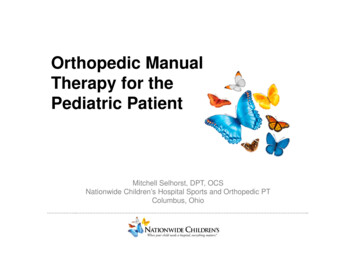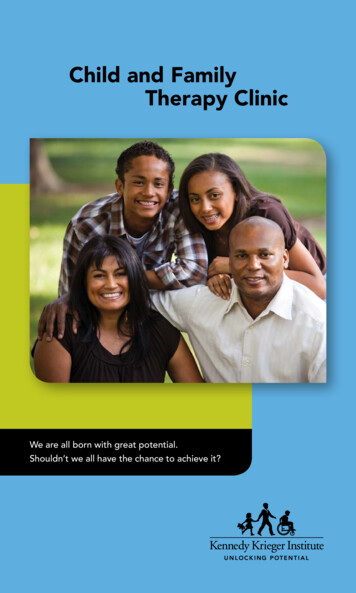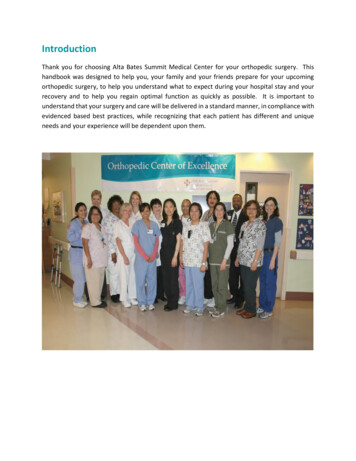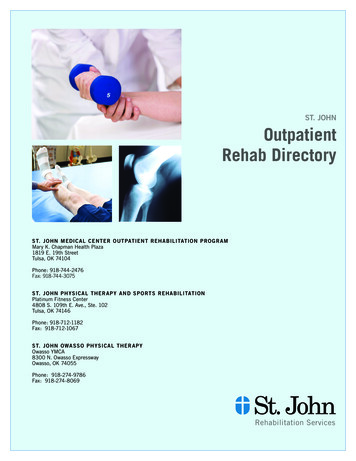
Transcription
Orthopedic ManualTherapy for thePediatric PatientMitchell Selhorst, DPT, OCSNationwide Children’s Hospital Sports and Orthopedic PTColumbus, Ohio . .
Learning ObjectivesThe attendee will: Understand the specific precautions and therelative risk of performing orthopedic manualtherapy on pediatric patients. Identify pediatric patients who are appropriatefor orthopedic manual therapy. Use orthopedic manual physical therapy tominimize pain and maximize function in pediatricorthopedic patients. . .
Pediatric Physical Therapy . .
This is the Pediatric I Mean
Kids Need PT Too!
Pediatric Pain is Not Benign Injury in childhood may lead to increasedrisk of pain in adulthood.23 Pain does not go away on its own– 2/3 of adolescents with low back pain willhave chronic or recurrent symptoms 6 monthslater.38
Clinical Practice Guidelines Recommenduse of Manual Therapy
Alright, Let’s Do Manual Therapy!Wait Growing Children . .
Contraindications and Precautions Contraindication: A circumstance whichabsolutely rules out the use of atherapeutic method which would otherwisebe indicated. Precaution: The risks of a treatment haveto be carefully assessed before treatmentis initiated, and it can only be administeredif its benefits to the patient are greaterthan its risks . .
Why are Children a Precautionfor Manual Therapy?Controversial: Not all authors agree that agrowing child is a precaution. Growth plates and cartilage endplates Ability to give informed consent Lack of research . .
Growth andCartilage End PlatesGrowth PlatesAge of OssificationWrist17‐19 yearsElbow15‐18 yearsShoulder19‐25 yearsHip18‐25 yearsKnee19‐25yearsFoot and Ankle18‐20 yearsEnd PlatesAge of OssificationCervical16‐18 yearsThoracic16‐18 yearsLumbar16‐18 yearsSacrum18‐25 yearsFemales 1-2 years sooner than males
Forces of Manual Therapyvs Normal Activity
What is the Risk MT willdamage a growth plate? Unknown: No documented case of growthplate injury has occurred due to manualtherapy.– 10,000,000 manual therapy interventionsperformed on children every year.– 2.3 million performed in the US alone.31 . .
Gaining Informed Consentfrom a Child A minor cannot provide informed consent Discussion of the risks and benefits ofmanual therapy becomes a familydiscussion
Risks from Lack of Research Children are not tiny adults, manyresearch results are not generalizable. We don’t know what we don’t know . .
Children are Not Tiny AdultsI wish I had hairSkeletally MatureAvoids Activity90% NonSpecific LBP?I have hairGrowth PlatesRemains Active 50% NonSpecific LBP?
Ruling out Cancer for Back Pain Negative on all 4 of these 100% sensitive– Age 50 years of age– Previous history of cancer– Unexplained weight loss– Failure to improve with conservativemanagement . .
Rely on your Red Flags Persistent painIncreases at restProgressive neurological deficitsAssociated feverNight painBowel or bladder incontinence . .
Ruling out Fractures Ottawa Ankle Rules28OK! Ottawa Knee Rules37OK! Canadian C-Spine Rules STOP!-Patients 10 years12OK!-Patient 10 years12 Not Sensitive Enough
Can we use CPR’s to guidemanual treatment? Manipulation for low back pain14– Pain for 16 days– No pain distal to the knee– 1 Lumbar segment hypomobile– Hip IR 35 degrees– FABQ-work subscale score 19?10-30% more hip IRmotion in children
Can we use a Modified CPRfor Lumbar ManipulationPatient meets 3 out of the 4––––Pain for 16 daysNo pain distal to the knee1 Lumbar segment hypomobileHip IR 35 degreesORPatient have both of the following-Pain for 16 days-No pain distal to the kneeIn a RCT assessing lumbarmanipulation in adolescents,only 5% met either of thesemodified rules. Unable toassess the effectiveness ofthese CPR’s.38
How to Identify AppropriatePatients for Manual TherapyDoes the clinician think the patientwould benefit from MT?NoYesYesContraindications?NoYesDo risks outweighthe benefits?NoNo improvementManual TherapyNot AppropriateTrial MTPositive Outcome.Continue as Indicated
Case of Low Back Pain13-year-old female– 2-month hx of LBP– Insidious onset– Has not improved overpast 4 weeks– No report of pain, NT, orweakness in LE’s– No red flags noted duringevaluation
Case of Low Back Pain13-year-old female with 2-month hx of LBP-Recreational dancer (Hip Hop and Ballet) 4hours of class a week.-Pain is worse with activity(2/10 at rest 6/10pain during dance)-Pain increases by 2/10 with lumbar extension-Scored a 14/30 on Patient Specific Functional ScaleDance 4/10Bending backwards 5/10Walking for 20 minutes 5/10
Should We Utilize ManualTherapy with this Patient?
Treatment Consideration forthe pediatric lumbar spine Much of pediatric back pain has ananatomical cause, some can beprecautions or contraindications to manualtherapy Up to 50% of adolescent athletes with lowback pain have a spondylolysis orspondylolisthesis.43
SpondylolysisTypeNamePathogenisisType IDysplasticCongenital abnormalitiesType IIIsthmicStress fracture in the parsinterarticularisType IIIDegenerativeDegeneration of the intervertebraldiscsType IVTraumaticAcute fracture in areas other thanparsType VPathologicalBone disease, tumor, or infection
Grades of SpondylolisthesisGrade of ‐listhesisGrade I% Slippage of thevertebral body1‐25%Grade II26‐50%Grade III51‐75%Grade IV76‐100%
Pediatric Spondylolytic InjuryAcute LesionChronic LesionLesion with anterolisthesisIncreased uptake (SPECT)or edema (MRI) noted inthe symptomatic regionLesion diagnosed but nosigns of active healingnoted on imagingGrade I‐IVCan be determined byX‐ray, CT, MRIActive fractureManual Therapy iscontraindicated in regionFibrous lesion, unlikely toachieve bony union.Manual Therapy is aprecautionPrecaution orContraindicationDepending on Grade andstability of ‐listhesis
Are there contraindication formanual therapy?13-year-old female with 2-month hx of LBP– ImagingX-ray - NegativeMRI - Negative
Risk and Benefits of ManualTherapy with this Patient? Physical therapy, including manualtreatment, results in significantly betteroutcomes in children with back pain.1 Lumbar manipulation does not increaserisk of an adverse event in adolescentswith non-specific low back pain.38
Trial Manual Therapy!
A Case of Neck Pain9-year-old male injured hisneck 3 days ago whiletackling in youth football.– Current patient (left shoulder)– Reports 7/10 right midcervical pain– No report of numbness ortingling– Significant TTP of R C3-4
A Case of Neck Pain9-year-old male injured duringyouth football– Patient maintained consciousness– Not a helmet-to-helmet collision– Active cervical ROMFlexion 65 deg. Ext 20 deg.*Rotation L 75 deg. R 50 deg*.– Difficulty sleeping at night due to pain– No signs or symptoms of concussion
Should We Utilize ManualTherapy with this Patient?
Are there contraindicationsfor manual therapy? Unable to rule out cervical fracture.– No imaging to rule out fracture.– Canadian C-spine Rules not sensitive enough. . .
Thumbs Down
A Case of Swimmers Shoulder11-year-old female with R shoulder pain Clinical diagnosis of secondary GHimpingement and multi-directional instability. Generalized hypermobility noted Beighton score of 6 out of 9
A Case of Swimmers Shoulder11-year-old female with R shoulder pain Hawkins-Kennedy Painful Arc ER weakness Excessive anteriorGH joint laxity Sulcus sign- Apprehension
Should We Utilize ManualTherapy with this Patient?
Are there contraindicationsfor manual therapy?Generalized Hypermobility is considered aprecaution by most, a few consider it acontraindication.– When treating a patient with hypermobility, thetherapist should examine opposite motionsand neighboring segments to find out if anyrestrictions exist.
Risks vs Benefits Risks: Manual therapy done incorrectlycould increase the patient’s hypermobilityand multi-directional instability. Benefits: Restoring motion to neighboringsegments could improve proper GH jointmechanics- 2 case studies support thistheory.7, 27
Trial Manual TherapyTarget restricted areas:– Posterior Shoulder– Pec Minor– Thoracic Extension– Scapular thoracic
A Case Acute Ankle Sprain15-year-old male with L inversion ankle sprain– 5-days post injury– Does not participate in sports– Fell off obstacle course androlled his ankle– No imaging performed– Presents to clinic on crutchesand ACE wrap
A Case of Acute Ankle Sprain15-year-old male with L inversion ankle sprain– Patient is able to walk in clinicwithout use of crutches withantalgic gait– TTP at ATFL– Talar Tilt, Anterior drawer (pain)– No tenderness at medial/lateralmalleoli, navicular or base 5thmetatarsal– Mild swelling noted upon visualexamination
Should We Utilize ManualTherapy with this Patient?
Are there contraindicationsfor manual therapy? Rule out fracture with the Ottawa AnkleRules. No other precautions or contraindicationsnoted
Risks vs BenefitsRisks: Minimal. No adverse reaction notedin research for this populationBenefits: Short and long-term benefitsnoted with use of manual therapy for acuteankle sprain.44, 45
Trial Manual Therapy!
Conclusion Manual therapy can be an effective way tominimize pain and maximize function inpediatric orthopedic patients. Weigh the risks and benefits beforeproceeding Rely on patient history, your clinicalexpertise, and the patient’s preferenceuntil there is better research to guide EBP. . .
References1.Ahlqwist A, Hagman M, Kjellby-Wendt G, Beckung E. Physical therapy treatment of back complaints onchildren and adolescents. Spine. 2008;33(20):E721-7. Epub 2008/09/17.2.Alqarni AM, Schneiders AG, Cook CE, Hendrick PA. Clinical tests to diagnose lumbar spondylolysis andspondylolisthesis: A systematic review. Physical therapy in sport : official journal of the Association ofChartered Physiotherapists in Sports Medicine. 2015. Epub 2015/03/24.3.Bialosky JE, Bishop MD, Price DD, Robinson ME, George SZ. The mechanisms of manual therapy inthe treatment of musculoskeletal pain: a comprehensive model. Manual therapy. 2009;14(5):531-8. Epub2008/11/26.4.Blanch P. Conservative management of shoulder pain in swimming. Physical Therapy in Sport.2004;5(3):109-24.5.Bruggeman G. Biomechanics in gymnastics. Med Sport Science. 1987;25:142 Y 76.6.Calvo-Munoz I, Gomez-Conesa A, Sanchez-Meca J. Physical therapy treatments for low back pain inchildren and adolescents: a meta-analysis. BMC musculoskeletal disorders. 2013;14:55. Epub 2013/02/05.7.Carson PA. The rehabilitation of a competitive swimmer with an asymmetrical breaststroke movementpattern. Manual therapy. 1999;4(2):100-6. Epub 1999/10/06.8.Chen KC, Chiu EH. Adolescent idiopathic scoliosis treated by spinal manipulation: a case study.Journal of alternative and complementary medicine (New York, NY). 2008;14(6):749-51. Epub 2008/08/05.
References9.Clifford SN, Fritz JM. Children and adolescents with low back pain: a descriptive study of physicalexamination and outcome measurement. The Journal of orthopaedic and sports physical therapy.2003;33(9):513-22. Epub 2003/10/04.10. DeVocht JW, Pickar JG, Wilder DG. Spinal manipulation alters electromyographic activity of paraspinalmuscles: a descriptive study. Journal of manipulative and physiological therapeutics. 2005;28(7):465-71.Epub 2005/09/27.11. d'Hemecourt PA, Luke A. Sport-specific biomechanics of spinal injuries in aesthetic athletes (dancers,gymnasts, and figure skaters). Clinics in sports medicine. 2012;31(3):397-408. Epub 2012/06/05.12. Ehrlich PF, Wee C, Drongowski R, Rana AR. Canadian C-spine Rule and the National Emergency XRadiography Utilization Low-Risk Criteria for C-spine radiography in young trauma patients. Journal ofpediatric surgery. 2009;44(5):987-91. Epub 2009/05/13.13. Evans DW. Mechanisms and effects of spinal high-velocity, low-amplitude thrust manipulation: previoustheories. Journal of manipulative and physiological therapeutics. 2002;25(4):251-62. Epub 2002/05/22.14. Flynn T, Fritz J, Whitman J, Wainner R, Magel J, Rendeiro D, et al. A clinical prediction rule for classifyingpatients with low back pain who demonstrate short-term improvement with spinal manipulation. Spine.2002;27(24):2835-43. Epub 2002/12/18.15. Fritz JM, Koppenhaver SL, Kawchuk GN, Teyhen DS, Hebert JJ, Childs JD. Preliminary investigation ofthe mechanisms underlying the effects of manipulation: exploration of a multivariate model including spinalstiffness, multifidus recruitment, and clinical findings. Spine. 2011;36(21):1772-81. Epub 2011/03/02.16. Frost DM, Beach T, Fenwick C, Callaghan J, McGill S. Is there a low-back cost to hip-centric exercise?Quantifying the lumbar spine joint compression and shear forces during movements used to overload thehips. Journal of sports sciences. 2012;30(9):859-70. Epub 2012/04/04.
References17. Gal. Biomechanical studies of spinal manipulative therapy (SMT) quantifying the movements ofvertebral bodies during SMT. Journal of CCA. 1994;38(1):1518. Gatt CJ, Jr., Hosea TM, Palumbo RC, Zawadsky JP. Impact loading of the lumbar spine duringfootball blocking. Am J Sports Med. 1997;25(3):317-21.19. Gatterbauer A. Contraindications in Osteopathy. Vienna: Danube University Krem; 2009.20. Grindstaff TL, Beazell JR, Sauer LD, Magrum EM, Ingersoll CD, Hertel J. Immediate effects of atibiofibular joint manipulation on lower extremity H-reflex measurements in individuals with chronic ankleinstability. Journal of electromyography and kinesiology : official journal of the International Society ofElectrophysiological Kinesiology. 2011;21(4):652-8. Epub 2011/05/07.21. Haun DW, Kettner NW. Spondylolysis and spondylolisthesis: a narrative review of etiology, diagnosis,and conservative management. Journal of chiropractic medicine. 2005;4(4):206-17. Epub 2005/01/01.22. Hayden JA, Mior SA, Verhoef MJ. Evaluation of chiropractic management of pediatric patients withlow back pain: a prospective cohort study. Journal of manipulative and physiological therapeutics.2003;26(1):1-8. Epub 2003/01/18.23. Hestbaek L, Leboeuf-Yde C, Kyvik KO, Manniche C. The course of low back pain from adolescenceto adulthood: eight-year follow-up of 9600 twins. Spine. 2006;31(4):468-72. Epub 2006/02/17.24. Humphreys BK. Possible adverse events in children treated by manual therapy: a review. Chiropractic& osteopathy. 2010;18:12. Epub 2010/06/08.25. Koppenhaver SL, Fritz JM, Hebert JJ, Kawchuk GN, Childs JD, Parent EC, et al. Association betweenchanges in abdominal and lumbar multifidus muscle thickness and clinical improvement after spinalmanipulation. The Journal of orthopaedic and sports physical therapy. 2011;41(6):389-99. Epub 2011/04/08.
References26. Lanthois PE, Pollard H. Spondylolysis in a professional fast bowler. A case study. Australasianchiropractic & osteopathy : journal of the Chiropractic & Osteopathic College of Australasia.1997;6(1):1-9. Epub 1997/03/01.27. Leao Almeida GP, De Souza VL, Barbosa G, Santos MB, Saccol MF, Cohen M. Swimmer'sshoulder in young athlete: rehabilitation with emphasis on manual therapy and stabilization of shouldercomplex. Manual therapy. 2011;16(5):510-5. Epub 2011/01/22.28. Libetta C, Burke D, Brennan P, Yassa J. Validation of the Ottawa ankle rules in children. Journalof accident & emergency medicine. 1999;16(5):342-4. Epub 1999/10/03.29. Loudon JK, Reiman MP, Sylvain J. The efficacy of manual joint mobilisation/manipulation intreatment of lateral ankle sprains: a systematic review. British journal of sports medicine.2014;48(5):365-70. Epub 2013/08/28.30. McDevitt A, Young J, Mintken P, Cleland J. Regional interdependence and manual therapydirected at the thoracic spine. Journal of Manual & . Ndetan H, Evans MW, Jr., Hawk C, Walker C. Chiropractic or osteopathic manipulation forchildren in the United States: an analysis of data from the 2007 National Health Interview Survey.Journal of alternative and complementary medicine (New York, NY). 2012;18(4):347-53. Epub2012/03/06.32. O'Neal ML. The pediatric spine: anatomical and dynamic considerations preceding manipulation.Comprehensive therapy. 2003;29(2-3):124-9. Epub 2003/11/11.
References33. Pellow JE, Brantingham JW. The efficacy of adjusting the ankle in the treatment of subacute and chronicgrade I and grade II ankle inversion sprains. Journal of manipulative and physiological therapeutics.2001;24(1):17-24.34. Pickar JG. Neurophysiological effects of spinal manipulation. The spine journal : official journal of theNorth American Spine Society. 2002;2(5):357-71. Epub 2003/11/01.35. Puentedura EJ, O'Grady WH. Safety of thrust joint manipulation in the thoracic spine: a systematicreview. Journal of Manual & Manipulative Therapy.0(0):2042618615Y.0000000012.36. Redwood D. Advances in manual therapy for children. Journal of alternative and complementarymedicine (New York, NY). 2011;17(3):185-6. Epub 2011/03/23.37. Robertson J. The Ottawa Knee Rules accurately identified fractures in children with knee injuries.Evidence-based nursing. 2004;7(1):24. Epub 2004/03/05.38. Selhorst M, Selhorst B. Lumbar manipulation and exercise for the treatment of acute low back pain inadolescents: a randomized controlled trial. Journal of Manual & Manipulative Therapy.2015;0(0):2042618614Y.0000000099.39. Todd AJ, Carroll MT, Robinson A, Mitchell EK. Adverse Events Due to Chiropractic and Other ManualTherapies for Infants and Children: A Review of the Literature. Journal of manipulative and physiologicaltherapeutics. 2014. Epub 2014/12/03.
References40. Vaughn DW, Kenyon LK, Sobeck CM, Smith RE. Spinal manual therapy interventions forpediatric patients: a systematic review. The Journal of manual & manipulative therapy. 2012;20(3):1539. Epub 2013/08/02.41. Vohra S, Johnston BC, Cramer K, Humphreys K. Adverse events associated with pediatric spinalmanipulation: a systematic review. Pediatrics. 2007;119(1):e275-83. Epub 2006/12/21.42. Riddle G, Ross O, Spellane V. Orthopedic issues and treatment strategies for the pediatricpatient. Exercise Considerations for the pediatric patient. APTA. 200943. Micheli LJ, Wood R. Back pain in young athletes. Significant differences from adults in causes andpatterns. Archives of pediatrics & adolescent medicine. 1995;149(1):15-8. Epub 1995/01/01.44. Cleland JA, Mintken PE, McDevitt A, Bieniek ML, Carpenter KJ, Kulp K, et al. Manual physicaltherapy and exercise versus supervised home exercise in the management of patients withinversion ankle sprain: a multicenter randomized clinical trial. The Journal of orthopaedic andsports physical therapy. 2013;43(7):443-55. Epub 2013/05/01.45. Whitman JM, Cleland JA, Mintken PE, Keirns M, Bieniek ML, Albin SR, et al. Predicting short-termresponse to thrust and nonthrust manipulation and exercise in patients post inversion anklesprain. The Journal of orthopaedic and sports physical therapy. 2009;39(3):188-200. Epub2009/03/03.
the pediatric lumbar spine Much of pediatric back pain has an anatomical cause, some can be precautions or contraindications to manual therapy Up to 50% of adolescent athletes with l










